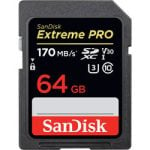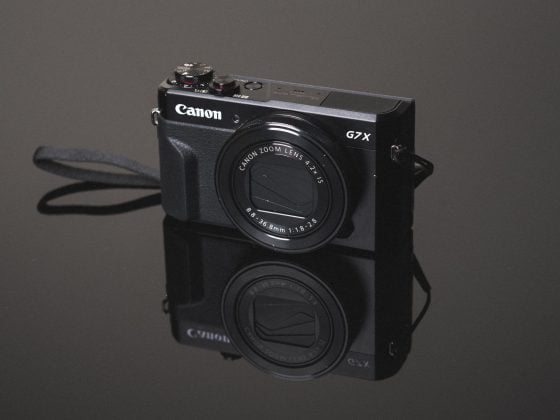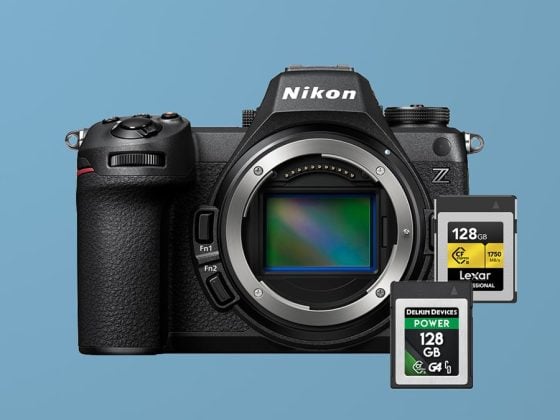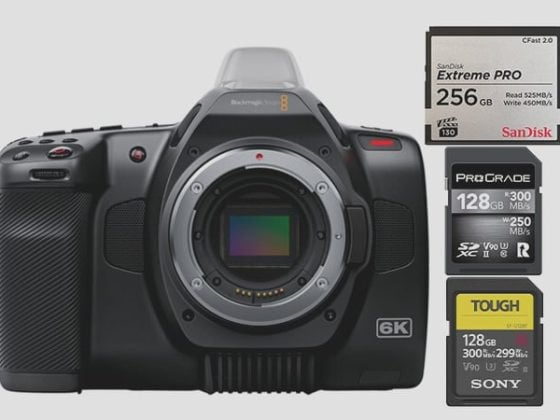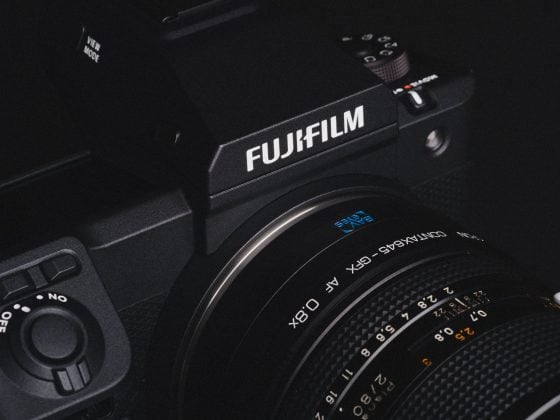The RX10 III has a single SD card slot that supports the UHS-I speed class. When testing memory cards in the camera we found peak write speeds of around 32MB/s. So you definitely won’t need the fastest cards out there to get great use out of this camera.
When looking at video the Sony RX10 III shoots at a bitrate of around 100Mbps, so if you plan on recording a lot of videos that is about 12.5MB/s. Just make sure you buy a card that has a minimum of a U3 or V30 speed class.
The max capacity of the Sony RX10 III is 128GB although some users are getting results with bigger cards. As a precaution, I’d recommend a 64-128GB memory card.
Recommended Memory Cards Sony RX10 III
These recommendations should get you started with some of the best cards for this camera today.
| Recommended SD Cards | Speed Class | USB Write | USB Read | Links | |
|---|---|---|---|---|---|
| SD UHS-II V60 | UHS-II | Hide | Hide | ||
| Sony E v60 256GB | UHS-II | https://geni.us/ARfXs | Amazon / B&H | ||
| UHS-I U3 | UHS-I | Hide | Hide | ||
| Sandisk Extreme Pro 32/64/128GB | UHS-I | 144 | 172 | https://geni.us/AjId | Amazon / B&H |
| Kingston CanvasGo! 128/256/512GB | UHS-I | 124 | 161 | https://geni.us/oJU7q | B&H |
| Sony 95 | UHS-I | 81 | 90 | https://geni.us/wnX8rG | Amazon |
| Delkin Advantage 32-1TB | UHS-I | 77 | 93 | https://geni.us/HlTWWVh | Amazon / B&H |
Also, see the latest memory card with their speeds tested.
Sony RX10 III Memory Card Speed Chart
I tested this camera and when looking at the speed charts, you can see the bottleneck with most of these older cards was around 32MB/s so there is not any huge reason to hunt for the fastest cards out there. Many of these cards are old in these benchmarks but don’t expect to see better performance with modern cards as the limitation is with the camera, not the cards.
| SD Memory Cards | USB 3.0 Read | USB 3.0 Write | Sony RX10 III Write |
| UHS-II | |||
| Lexar 2000x U3 64GB | 280.9 MB/s | 181.4 MB/s | 31.96 MB/s |
| Transcend U3 64GB | 268.9 MB/s | 174.3 MB/s | 31.45 MB/s |
| Toshiba U3 64GB | 238.5 MB/s | 199.7 MB/s | 31.28 MB/s |
| Delkin UHS-II U3 32GB | 245.1 MB/s | 164.6 MB/s | 30.70 MB/s |
| Sony UHS-II U3 64GB | 253.2 MB/s | 91.62 MB/s | 30.69 MB/s |
| Lexar 1000x U3 64GB | 145.0 MB/s | 60.7 MB/s | 30.59 MB/s |
| Sandisk Extreme Pro U3 64GB | 257.3 MB/s | 109.9 MB/s | 30.28 MB/s |
| UHS-I | |||
| Samsung Pro+ 64GB U3 | 97.5 MB/s | 87.3 MB/s | 32.00 MB/s |
| Sandisk Extreme Pro 64GB U3 | 98.6 MB/s | 90.8 MB/s | 31.91 MB/s |
| Samsung Pro 64GB U3 | 97.7 MB/s | 78.6 MB/s | 31.81 MB/s |
| Sandisk Extreme Plus 64GB U3 | 99.0 MB/s | 64.4 MB/s | 31.79 MB/s |
| Sandisk Extreme 64GB U3 | 72.43 MB/s | 54.1 MB/s | 31.60 MB/s |
| PNY 64GB U1 | 96.5 MB/s | 66.5 MB/s | 31.56 MB/s |
| Kingston 64GB U3 | 98.1 MB/s | 90.4 MB/s | 31.43 MB/s |
| Samsung Pro 64GB U1 | 96.3 MB/s | 82.2 MB/s | 31.09 MB/s |
| PNY 64GB U3 | 96.5 MB/s | 66.1 MB/s | 30.50 MB/s |
| Lexar 600x 64GB U1 | 95.4 MB/s | 64.8 MB/s | 30.32 MB/s |
| Transcend 64GB U3 | 96.7 MB/s | 68.4 MB/s | 30.27 MB/s |
| Sony 64GB U3 (Old Model) | 96.5 MB/s | 84.5 MB/s | 30.04 MB/s |
| Lexar 633x 64GB U3 | 93.3 MB/s | 67.3 MB/s | 29.91 MB/s |
| Sony 64GB U3 (New Model) | 96.7 MB/s | 56.2 MB/s | 29.17 MB/s |
| Samsung 64GB SDXC EVO U1 | 47.7 MB/s | 27.3 MB/s | 23.83 MB/s |
Camera Specs
Sensor: 1″ 20.1MP / Processor: BIONZ X
Memory Card Type: SD UHS-I
Video: 3840 x 2160p: 30 fps, 24 fps
Est. Size Of Buffer: 500MB
Continues Shooting Speed: 14fps
Shots To Fill Buffer: 30 RAW
Time To Clear Buffer: 14.5 seconds
Best Memory Card For Video In The Sony RX10 III
The Sony RX10 III requires U3 memory cards for 4K video recording. You may also see memory cards with V30, V60, or V90 labels, which are also compatible. However, UHS-II cards are unnecessary, as the camera cannot use their full speed.
Frequently Ask Questions
I’ve been doing these memory card speed tests for several years now and I get a lot of the same questions asked, so I’ll do my best to answer those here.
Do I need a UHS-II Memory Card? – You do not need a UHS-II memory card and they actually will give you no benefit over a UHS-I memory card when used in camera. The only difference a UHS-II memory card will make in the Sony RX10 III is it will allow you to transfer your data to your computer quickly if you have a fast UHS-II memory card reader.
What’s the difference between U1 and U3 SD Memory cards? – The main difference has to do with minimum write speeds. U1 cards are guaranteed to write at a minimum speed of 10MB/s, and U3 SD memory cards can write at a minimum speed of 30MB/s. Now of course many things go on inside the camera that might not guarantee this, but it’s usually not the card’s fault. You’ll also start seeing V30, V60, and V90 written on cards. This has to do with the minimum write speeds V30 – 30MB/s, V60 – 60MB/s, and V90 – 90MB/s.
What’s the difference between SDHC and SDXC with SD memory cards? – This has to do with the formatting of the card. SDHC cards are Fat32, and SDXC cards are exFat. Now pretty much SDHC means any card 32GB and smaller, and SDXC means 64GB and larger.
My memory card is creating corrupt shots what do I do? – Unfortunately in this situation, you likely have a bad card. There isn’t a lot you can do about this other than to replace your card.
My memory card doesn’t work what do I do? – You could likely have a bad memory card, but also make sure you always format your card in the camera. This tends to reduce issues with cards not working or not performing correctly.
My buffer keeps getting filled when recording video. – This usually means you’re memory card is not fast enough and you’ll need to get a faster card. If you already have a card on the list above, you should try a different brand. Not all cameras work the same with each card, different production cycles between cameras and cards can produce various results and there is no guarantee the cards I rated will work perfectly with your camera. Lexar, Toshiba, Samsung, and Sandisk are usually pretty safe bets.
Can I use Micro SD memory cards? – Yes you can, but there are a lot of crappy out there. I have just about every one made so just leave me a comment if you want to know if they work or not.
Best Memory Card For The Sony RX10 III | Conclusions
The Sony RX10 III is an old camera that was released in 2016, and it has a single SD card slot that supports UHS-I speed class. This means that you don’t need the latest and fastest cards on the market, but you still need reliable and high-capacity cards that can handle the large file sizes and high bitrates of this camera, especially if you shoot in raw or 4K video.
| **This website contains affiliate links. We will earn a small commission on purchases made through these links. Some of the links used in these articles will direct you to Amazon. As an Amazon Associate, I earn from qualifying purchases. |

